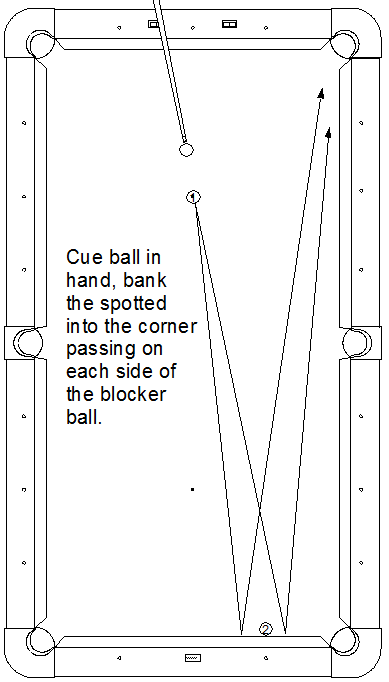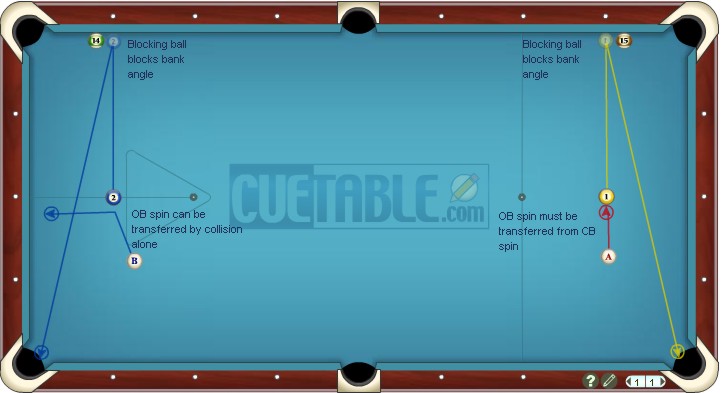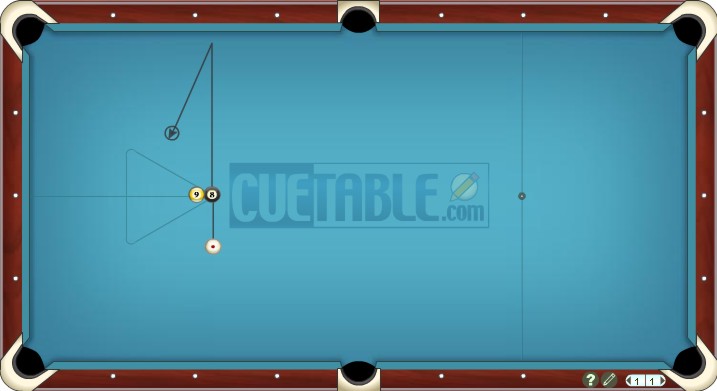Can you prove to me that spin can be transferred from the cue ball to an object ball?
First, any time there is throw, there is spin transfer. The friction force between the CB and OB that causes throw also creates a torque or moment about the OB’s center, imparting sidespin. For the non-believers out there, I have several resources available to prove that spin transfer exists. HSV A.66 provides a slow-motion video demonstration of the effect … the spin transfer is clearly visible! Here’s another:
For the physics nerds out there, TP A.27 provides a mathematical proof. And for people who need to see shot examples, here’s one that relies on both throw and spin transfer:
For more information, see “Throw – Part VIII: spin transfer” (BD, March, 2007).
With shots like the one in the video above, throw and spin transfer are maximum at slower speeds with about 50% english (half maximum). However, at slow speeds, more of the transferred spin will wear off on the way to the rail, so the optimal speed (for the spin-transfer rebound-angle-change effect) will depend on conditions and the distance to the rail.
Here are more examples showing how spin transfer affects bank shots:
Other bank shots that rely on spin transfer are twice across and three-times-across bank shots. Here’s another spin-transfer bank shot with a timed kiss clearly showing the effects of spin transfer:
And here’s another spin-transfer bank shot example where the transferred spin changes the rebound angle enough to avoid a double kiss:
Here are some other videos (also see the illustrations posted by others below) showing the effects spin transfer:
Also, HSV A.143-A.146 illustrate spin transfer and “vertical throw” (ball hop) resulting from topspin or bottom-spin. Notice how the effects are much greater when chalk is added to the object ball surface. Remember: keep those balls clean. Here is another video, with explanations, on the same topic: HSV B.46 – CB and OB hop and spin transfer during follow shots, Here’s an example of how bottom-spin on the CB can transfer a small amount of topspin to the OB to achieve slight OB follow:
Whenever there is throw (SIT or CIT), there is spin transfer (SIS:spin-induced spin or CIS:cut-induced spin); and the more throw you have, the more spin transfer you have. It is a small amount of spin, but as shown in the videos above, it makes a big difference with bank shots (e.g., with an inside cut, the bank is lengthened; and with an outside cut, the bank is shortened). For more info, see bank and kick effects. Sometimes the phrase “twist the bank in” is used to describe shots like this, where spin transferred to the object ball is used to alter the bank rebound angle. For more info, see bank-shot cut-induced spin effects.
Here are good examples of SIT and CIS with frozen combos:
Section 40 (Spin Transfer Shots) in Vol. IV of the Video Encyclopedia of Pool Shots presents several types of shots (with many examples) where cut-induced spin (CIS) and spin-induced spin (SIS) are important factors. Many trick shots also rely on, or are affected by, throw and spin transfer. For examples, see famous trick shots. Here’s an example of spin transfer in reverse, with a stunned ball hitting a stationary spinning ball:
from Bob Jewett (in AZB post):
Here’s a simple demo posed as a proposition shot. Under the right conditions, you can add a second blocker ball frozen to the 2 ball so the block is a full two balls wide. People who don’t know that you can spin the object ball could lose a lot of money at this proposition.

from Patrick Johnson:
In both setups (see below) the OB must have spin to go. However, the setup on the right needs CB spin in order to transfer spin to the OB, but the one on the left can transfer spin to the OB without spinning the CB.

from JB Cases:
…back in the olden days, back when balls would actually spot, this here shot (see below) used to come up all the time and we had to know how to make the 8 spin BELOW the 9 so that it would be safe. This shot very rarely comes up now.
The cue ball STOPS frozen to the 9 or just behind it. The 8 goes to the side rail and spins to the left going lower down table than the where the nine is. It was IMPOSSIBLE to hit the 8 ANYWHERE to the right of center or it would make the 9 move as well. So you have hit center ball with low right spin which then transfers left spin to the object ball.

Is it possible for the CB to pick up spin from on OB?
Yes. See:
Any time the CB throws and transfers spin to the OB, there is an equal and opposite effect on the CB. As Newton told us, for every action, there is an equal and opposite reaction. With a cut shot with no sidespin, the CB throws and transfers spin (cut-induced spin, or CIS) to the OB, and the CB picks up the same amount of spin in the reverse direction. With a direct hit with sidespin, the CB transfers spin to the OB in the opposite direction (spin-induced spin, or SIS) and the CB loses a corresponding amount of its spin. Both of these induced-spin effects are largest with maximum throw.
For more information and demonstrations, see the spin transfer and the bank shot cut-induced spin resource pages.
Dr. Dave keeps this site commercial free, with no ads. If you appreciate the free resources, please consider making a one-time or monthly donation to show your support:
